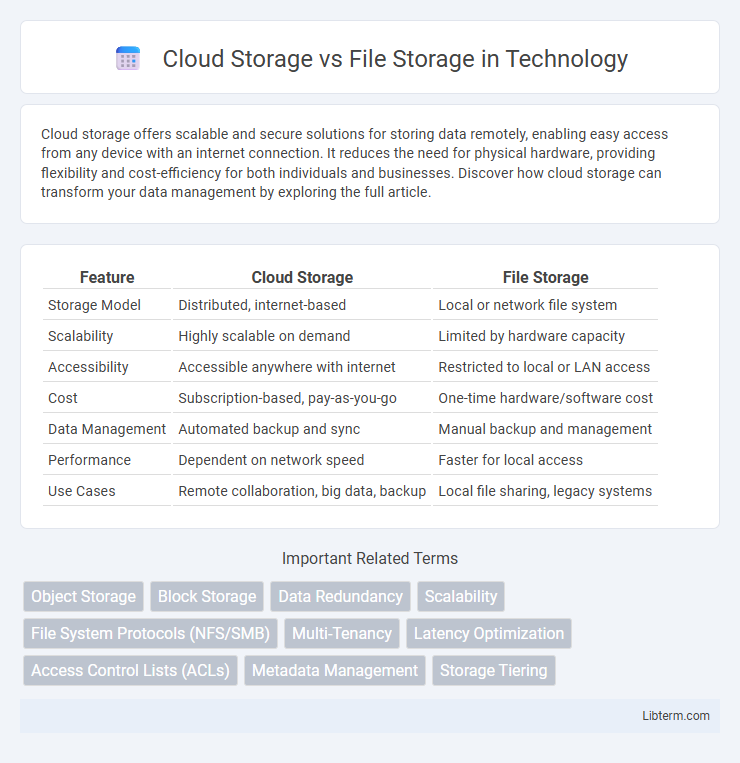Cloud storage offers scalable and secure solutions for storing data remotely, enabling easy access from any device with an internet connection. It reduces the need for physical hardware, providing flexibility and cost-efficiency for both individuals and businesses. Discover how cloud storage can transform your data management by exploring the full article.
Table of Comparison
| Feature | Cloud Storage | File Storage |
|---|---|---|
| Storage Model | Distributed, internet-based | Local or network file system |
| Scalability | Highly scalable on demand | Limited by hardware capacity |
| Accessibility | Accessible anywhere with internet | Restricted to local or LAN access |
| Cost | Subscription-based, pay-as-you-go | One-time hardware/software cost |
| Data Management | Automated backup and sync | Manual backup and management |
| Performance | Dependent on network speed | Faster for local access |
| Use Cases | Remote collaboration, big data, backup | Local file sharing, legacy systems |
Introduction to Cloud Storage and File Storage
Cloud storage enables users to save data on remote servers accessed via the internet, offering scalable capacity and flexibility for managing files and applications. File storage, typically associated with local or network-attached storage systems, organizes data in a hierarchical structure using folders and files, optimized for quick retrieval and collaboration. Understanding the distinctions between cloud and file storage helps businesses choose solutions based on accessibility, scalability, and performance requirements.
Key Differences Between Cloud Storage and File Storage
Cloud storage provides scalable, internet-based data access and is optimized for remote collaboration, while file storage refers to on-premises systems that organize data in a hierarchical structure for local access. Cloud storage leverages distributed infrastructure for redundancy and automatic backups, contrasting with file storage's reliance on physical hardware and manual management. Security models differ as cloud storage often includes advanced encryption and compliance capabilities, whereas file storage security depends on local network controls and permissions.
Types of Cloud Storage Solutions
Cloud storage solutions are categorized into object storage, block storage, and file storage, each suited to specific use cases. Object storage, such as Amazon S3 and Google Cloud Storage, is ideal for unstructured data and scalability, while block storage like AWS EBS and Azure Disk offers high-performance volumes for databases and applications. File storage solutions, including Amazon EFS and Azure Files, provide fully managed shared file systems supporting traditional file protocols for applications requiring file-level access.
Types of File Storage Systems
File storage systems consist primarily of Network Attached Storage (NAS) and Direct Attached Storage (DAS), with NAS offering file-level access over a network and DAS providing storage directly connected to a single server or workstation. Cloud storage systems, such as object storage and block storage, differ by distributing data across multiple servers for scalability and remote access, while file storage organizes data hierarchically with folders and files. Understanding these types highlights the trade-offs between localized file access in traditional file storage and the flexibility and accessibility of cloud-based file storage solutions.
Performance Comparison: Cloud vs File Storage
Cloud storage offers scalable access with potentially higher latency due to network dependency, while file storage provides lower latency through local or dedicated network connections. Performance in cloud storage varies based on bandwidth, data center location, and provider infrastructure, often suited for distributed access scenarios. File storage typically delivers faster read/write speeds for on-premises applications, making it optimal for workloads requiring rapid data retrieval and minimal delay.
Security Features in Cloud and File Storage
Cloud storage leverages advanced encryption protocols such as AES-256 for data at rest and TLS for data in transit, alongside multi-factor authentication (MFA) and regular compliance audits like SOC 2 and ISO 27001 to enhance security. File storage typically depends on network-based access controls, permissions, and encryption technologies, but may lack the comprehensive threat detection and real-time monitoring systems found in cloud environments. Cloud security frameworks often include automated backups, disaster recovery, and geographic redundancy, which provide robust protection against data loss and unauthorized access compared to traditional file storage solutions.
Scalability and Flexibility Considerations
Cloud storage offers unparalleled scalability by allowing businesses to dynamically increase or decrease storage capacity on demand, supporting rapid growth without the need for physical infrastructure investment. File storage systems, typically limited by on-premises hardware, often struggle to expand smoothly and may require costly upgrades or downtime. Flexibility in cloud storage is enhanced through seamless integration with diverse applications and remote access capabilities, whereas file storage solutions usually confine users to specific network environments and compatibility constraints.
Cost Analysis: Cloud Storage vs File Storage
Cloud storage typically offers scalable pricing models based on usage, reducing upfront capital expenses and enabling businesses to pay only for the storage they consume. In contrast, file storage often requires significant initial investment in physical hardware, ongoing maintenance costs, and potential over-provisioning to accommodate future growth. Analyzing total cost of ownership reveals cloud storage can lower operational expenses and increase financial flexibility, especially for fluctuating or unpredictable storage demands.
Use Cases and Best Practices
Cloud storage offers scalable and flexible solutions ideal for dynamic data access, backup, and disaster recovery scenarios, while file storage excels in structured environments requiring consistent file hierarchies and low-latency access, such as media production or software development. Best practices for cloud storage emphasize encryption, automated tiering, and integration with cloud-native tools to optimize performance and cost-efficiency; file storage implementations benefit from robust access controls, snapshot capabilities, and compatibility with legacy applications. Organizations should align their storage choice with specific workload demands, balancing scalability and accessibility against latency and compliance requirements.
Choosing the Right Storage Solution for Your Needs
Cloud storage offers scalable, remote access to data with robust redundancy and easy collaboration, ideal for businesses requiring flexibility and disaster recovery. File storage provides direct, high-performance access to file systems, suitable for applications needing low latency and specific permissions management. Selecting the right storage solution depends on factors like data access speed, budget, security requirements, and the scale of data management.
Cloud Storage Infographic

 libterm.com
libterm.com